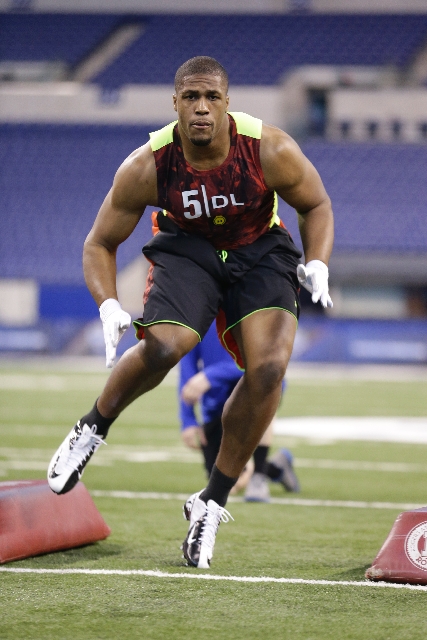Small-school prospects get fair look at NFL combine

INDIANAPOLIS — Armonty Bryant gets those awkward looks every time he tells someone he attends college at ECU.
The natural inclination is to ask about East Carolina. When he explains the school name is actually East Central, the next question, naturally, is East Central what?
No, Bryant is not the most prominent defensive lineman at the NFL scouting combine, and he doesn’t come from a school most fans have even heard of. Yet he impressed enough of the right people to earn one of 333 invitations to the annual event, where he could compete against all those big-name guys he’s been watching on television the last few years.
“I hear it all the time. They think it’s supposed to be East Central Michigan or something,” Bryan said. “East Central is in Ada, Okla. I like to say it’s in the middle of nowhere.”
Here, all 29 players from the non-Football Bowl Subdivision schools have a story. Some, such as Tennessee Tech receiver Da’Rick Rogers, are actually FBS transplants. Rogers landed with Tech last August after getting booted off Tennessee’s team for failing a drug test.
Others, such as Bryant and Azusa Pacific offensive lineman Luke Marquardt, outgrew their small-school monikers long ago, but never got a chance to face the bigger-name players until now. Bryant was listed at 6 feet 4 inches and 250 pounds last season. Scouts believe he can play either defensive end or outside linebacker.
Marquardt came to Indianapolis at 6-8½ and 315 pounds, and did 31 reps at 225 pounds on the bench press Friday.
The only real difference between them and their higher-profile colleagues? Probably visibility.
Bryant had only two scholarship offers in high school — Abilene Christian and East Central. Marquardt gave up football in high school, choosing instead to focus on basketball. When Azusa Pacific offered him scholarship money for football, he gave it a whirl. In 2½ years, he made the transition from walk-on basketball player to prized pupil of Pro Football Hall of Famer Jackie Slater, Azusa Pacific’s offensive line coach.
“Just by chance, we were walking by the head coach’s football locker, and I decided to go meet him,” Marquardt said. “He was like, ‘You have great size, great athleticism, and we’d love to have you come out for tight end,’ so I went out on the field, did a couple routes, threw with the quarterbacks, and they offered me a little bit of money, and then I eventually got a full-ride scholarship.”
Of course, it’s not that easy for everyone.
At 6-6, 325 pounds, Glenville State’s Mark Jackson has the size NFL scouts covet in an offensive lineman and is athletic enough to have caught a 14-yard TD pass on a tackle-eligible play in 2010.
Now he’s trying to rewrite history.
The last player to be drafted from Division II’s West Virginia Intercollegiate Athletic Conference was Salem’s Jeff Shaw in 1986. He went to the Bengals in the 10th round, a round that no longer exists in this seven-round draft. Former Broncos tight end Orson Mobley, also from Salem, was taken in the sixth round that year.
Twenty-seven years later, Jackson is the league’s best hope to end the drought.
“It kind of freaks me out,” Jackson said. “Going to Glenville State, I was a little worried about getting my exposure out there, but my coaches did a great job at putting my film together and getting it out there. There is some good football played in my conference.”
And somehow the scouts still found a guy like Jackson in a nook like Glenville, W. Va., population 1,538, with a student enrollment at Glenville State of fewer than 2,000.
In 2010, the scouts’ favorite diamond in the rough was offensive tackle Jared Veldheer from Hillsdale College in Michigan. He wound up going to the Raiders in the third round and has started 43 games over the past three seasons.
Going small school, though, doesn’t necessarily mean NFL teams are avoiding the kind of trouble that exists at bigger schools. Rogers, of course, admitted to the failed drug test, and Bryant is trying to rebuild his reputation after last fall’s arrest on charges of marijuana distribution in a school zone. He said a police officer spotted him selling marijuana to a friend in a dorm parking lot. Later, he was pulled aside at practice and subsequently arrested. Bryant said he was given a five-year deferred sentence and two years of supervised probation.
Being at a small school prevented the arrest from grabbing national attention and becoming Bryant’s legacy.
“Maybe it would have been a different situation, maybe it would have been handled differently,” Bryant said when asked about whether he had considered what the consequence might have been if he was at a BCS-conference school.
Instead, he continued to play and played well enough to earn a ticket to Indy, where he’s now lining up against the likes of Louisiana State’s Barkevious Mingo and Florida’s Sharrif Floyd and Alabama’s Jesse Williams.